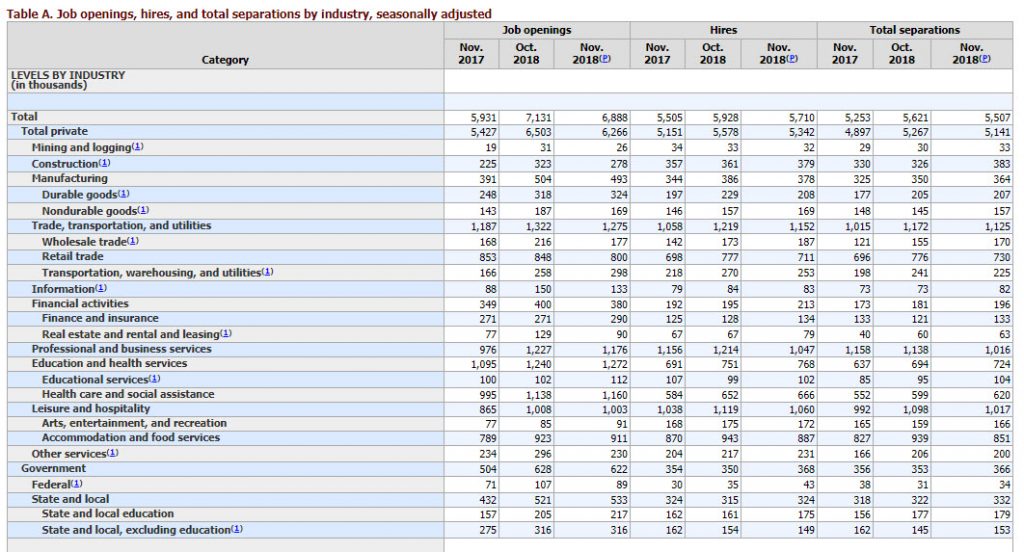The number of job openings fell to 6.9 million on the last business day of November, the U.S. Bureau of Labor Statistics reported today. Over the month, hires edged down to 5.7 million, quits edged down to 3.4 million, and total separations were little changed at 5.5 million. Within separations, the quits rate and the layoffs and discharges rate were unchanged at 2.3 percent and 1.2 percent, respectively. This release includes estimates of the number and rate of job openings, hires, and separations for the nonfarm sector by industry and by four geographic regions. Job Openings On the last business day of November, the job openings level fell to 6.9 million (-243,000). The job openings rate was 4.4 percent. The number of job openings decreased for total private (-237,000) and was little changed for government. Job openings increased in transportation, warehousing, and utilities (+40,000). The job openings level decreased in a number of industries, with the largest decreases in other services (-66,000) and construction (-45,000). Job openings fell in the West region. (See table 1.) Hires The number of hires edged down to 5.7 million (-218,000) in November. The hires rate was 3.8 percent. The hires level fell for total private (-236,000) and was little changed for government. Hires increased in federal government (+8,000) but decreased in professional and business services (-167,000). The number of hires decreased in the South region. (See table 2.) Separations Total separations includes quits, layoffs and discharges, and other separations. Total separations is referred to as turnover. Quits are generally voluntary separations initiated by the employee. Therefore, the quits rate can serve as a measure of workers’ willingness or ability to leave jobs. Layoffs and discharges are involuntary separations initiated by the employer. Other separations includes separations due to retirement, death, disability, and transfers to other locations of the same firm. The number of total separations was little changed at 5.5 million in November. The total separations rate was 3.7 percent. The number of total separations was little changed for total private and for government. Total separations decreased in professional and business services (-122,000) and in accommodation and food services (-88,000). The number of total separations was little changed in all four regions. (See table 3.) The number of quits edged down in November to 3.4 million (-112,000). The quits rate was 2.3 percent. The quits level edged down for total private (-122,000) and was little changed for government. Quits fell in professional and business services (-84,000) and in accommodation and food services (-62,000). The number of quits was little changed in all four regions. (See table 4.) The number of layoffs and discharges was little changed in November at 1.8 million. The layoffs and discharges rate was 1.2 percent. The layoffs and discharges level was little changed for total private and for government. Layoffs and discharges increased in educational services (+17,000). The number of layoffs and discharges was little changed in all four regions. (See table 5.) The number of other separations was little changed at 332,000 in November. The other separations level was little changed for total private and for government. Other separations increased in arts, entertainment, and recreation (+5,000) and in federal government (+4,000), but decreased in professional and business services (-22,000). The number of other separations increased in the Northeast region, but decreased in the Midwest and West regions. (See table 6.) Net Change in Employment Large numbers of hires and separations occur every month throughout the business cycle. Net employment change results from the relationship between hires and separations. When the number of hires exceeds the number of separations, employment rises, even if the hires level is steady or declining. Conversely, when the number of hires is less than the number of separations, employment declines, even if the hires level is steady or rising. Over the 12 months ending in November, hires totaled 68.0 million and separations totaled 65.6 million, yielding a net employment gain of 2.4 million. These totals include workers who may have been hired and separated more than once during the year.
Content is for general information purposes only. It is not investment advice or a solution to buy or sell securities. Opinions are the authors; not necessarily that of OANDA Business Information & Services, Inc. or any of its affiliates, subsidiaries, officers or directors. If you would like to reproduce or redistribute any of the content found on MarketPulse, an award winning forex, commodities and global indices analysis and news site service produced by OANDA Business Information & Services, Inc., please access the RSS feed or contact us at info@marketpulse.com. Visit https://www.marketpulse.com/ to find out more about the beat of the global markets. © 2023 OANDA Business Information & Services Inc.




